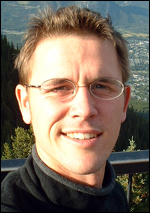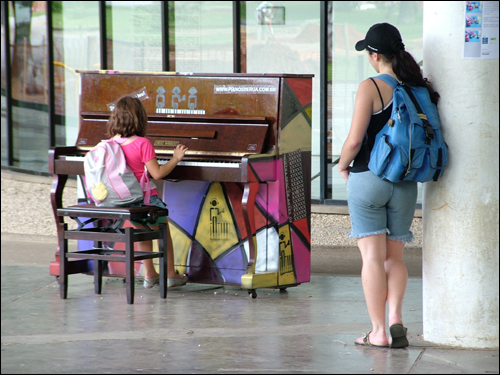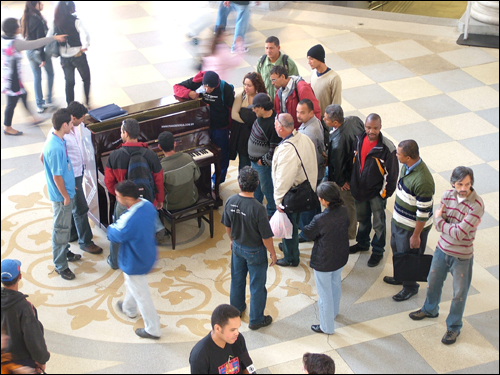|
|
Toque-me, Sou teu say signs stuck on free-to-use
public pianos in Dozens of pianos placed in public areas in those cities tempt passers-by of all ages to sit down and play their favorite pieces, for the benefit of anyone who stops to listen. Delighted audiences soon gather, often dancing to the music, or chanting the songs.
Public pianos were the brilliant idea of Luke Jerram, a British inventor, installation artist and science communicator. He designs and builds science exhibits whilst creating multimedia installation artworks in his home country and overseas.
In March 2008, 15 pianos which had been professionally tuned were installed, unguarded, in Birmingham, Britain's second city.
"There is one in the Rag Market, and one outside Cadbury World," Maev Kennedy reported in The Guardian. "There is another at Colmore junior school, where a teacher was persuaded into an impromptu recital dressed in white gown with veil fluttering in the icy wind. She had been on her way to her wedding."
"At €1,000 each (a year's wage for some people) many people had never seen a real piano before, let alone been given permission to play one," Jerram said later. "The project made national news there." Two clips from Sao Paulo TV: /(speech in Portuguese). Jerram invited online Sao Paulinos to tell him what they thought of the pianos and to post messages and videos on his Web site One commenter, Auro Augusto, wrote that he had heard a piano being played on a Sundaymorning at the Lux station ... Bach, Tchaikovsky. Then (as translated by Google): The most incredible, something that would never think that, (never seen in my 10 years of musical studies) a beggar (tattered and dirty, exhaled a smell that instigated people to come out of that person close) sat at the piano and incredibly started playing the first notes of the Moonlight Sonata (Beethoven).
In January 2009, Jerram visited Australia for the Sydney Festival. He arranged
for 30 pianos to be bought, tuned, and installed in parks, public squares, on
Harbor ferries and even in a tattoo parlor, for anyone to play.
"Whether it's Chopsticks or Chopin, chances are you'll hear it on the streets of Sydney this summer", said Rebecca Baillie in an ABC-TV 7.30 Report.
A youthful-looking Jerram told her, "I'm hoping these pianos will act as a catalyst to get people talking to one another, to kind of connect people."
Sydneysiders' comments, videos and photos are posted on this Web site www.streetpianos.com.au.
Jerram is so enthusiastic about the project that he has set up a special fund so that public pianos can be installed in "less wealthy" cities, including San Paulo.
He sees public pianos as an important way to promote community harmony.
"The pianos act as sculptural, musical, blank canvases that become a
reflection of the communities they are embedded into," he says. "Who
will play them and how long they remain is up to each community."
Jerram lives in Bristol, UK with his partner Shelina Nanji and children Maya and Nico.
He has been described as "a colour blind installation artist, who fuses his artistic sculptural practice with his scientific and perceptual studies." He has an impressive academic career fully described in his biography.
Back in 2005, an article by Lewis Smith in The Times (London) was headed "With this talking ring, inventor wins his girl." It reported:
Luke Jerram wanted to avoid a traditional proposal, so spent three months developing a ring that would play: "I love you forever. Marry me." Once it was ready, complete with a miniature record player, he took Shelina Nanji up in a hot air balloon and, while the pilot discreetly looked away, asked for her hand. She is now his fiancee.
It seems that Luke Jerram is both a gifted and a gift-giving performance artist.
Click on author's byline for bio and list of other works published by Pencil Stubs Online.Published 2009-03-31 10:14 (KST) in OhmyNews, International Art & Life produced by the OhmyNews Journalism School whose Syllabus states "Hundreds of people have learned the theory and practice of citizen journalism (at) The school, located in a small village on Kanghwa Island (south of Seoul), offers numerous courses on journalism writing, digital media techniques and writing practice, taught in Korean and English by... (Todd Thacker)
|




 Luke
Jerram
Luke
Jerram

